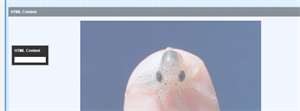Published
on
September 20, 2017
| 730 views
| 1 follower
members are following updates on this item.
Igloo has a lot of widgets. Widgets for every kind of content, sometimes more than one, for displaying contextual information, and for interpreting outside content, like RSS. Through all of those, the HTML Content widget is the workhorse and unsung hero of most of the Pages and Spaces in Igloo. Designed to be easy to use, it can accept any HTML or text you place in it, and can be placed anywhere on a page that you need. If you need a quick banner, video embed, or even a text announcement, the HTML Content widget is invariably your go to.
But it can do much more.
 Banners and Embeds
Banners and EmbedsWithin the HTML Content widget, you have access to the full Igloo text editor, letting you add images, embed Youtube videos, create links, or write text to your heart's content. The code view is also available, so you can fine-tune those changes until they match exactly what you need. Drag the widget around the Page to get it into the right place, and you're ready to go.
Having a tool this versatile on your Pages lets you place information that doesn't necessarily have a home elsewhere in your digital workplace in context, with supporting links and resources available in other widgets around it. You can add sidebar links or external RSS feeds to your technical guides, or add clarifying notes in your onboarding area, for example.
HTML Content widgets are indexed in search. Any text that's placed in there will return the Page the widget is on when you search for it, letting you search for Pages and Spaces by more than their titles. Not only can this be useful for locating announcements and indexes in context, you can add additional search terms to a Page by creating an HTML Content widget, adding a list of search terms in the text, and adding the "hide" class to create an area of hidden search terms. The hidden terms are still indexed, so your members will be able to find it using those terms as well.
When it comes to putting large blocks of text or menus on a Page or Space, both the HTML Content and the Wiki Article widgets can be useful. They can do similar things, but while each HTML Content widget is isolated to a specific Page, Wiki Articles pull their content from a source article. If the source article is edited, the edits appear in all of the Wiki Article widgets using it as a source. If you have a menu, banner, or block of text that you need to appear on multiple Pages and intend to edit regularly, the Wiki Article widget is the way to go.
The disadvantage of using Wiki Article widgets in this way is their searchability. A search for the terms in the article will return the article, but not the Pages it's embedded on. The search returns the sources, in the same way it does for Blog, Forum, or Calendar widgets. This can make it tricky to direct people to the information in context, and can make search results confusing for newcomers. You can work around this by Archiving the source articles, so they're excluded from default search, but while that cleans up the search results, it won't help people find the Page they're looking for. The HTML Content widget will let the search take them straight there.
Finally, the HTML Content widget has a special access setting that's unavailable to all other widgets. Because the content is only located there, and doesn't rely on access from other sources, you can use the "Show content to" dropdown make the widget available to everyone, members only, or non-members only. Using this, you can customize Pages so they appear differently to members than non-members, offering different calls to action. Maybe a Page prompts members to create content or browse deeper into the site, but non-members see a different HTML Content widget, directing them to join your Igloo. For public communities, this can create a single portal that welcomes members and non-members alike, while keeping the content relevant to each group.
For more information about using widgets in Igloo, read up on them in the Knowledge Base, or ask a question in the Community area.
Page Options